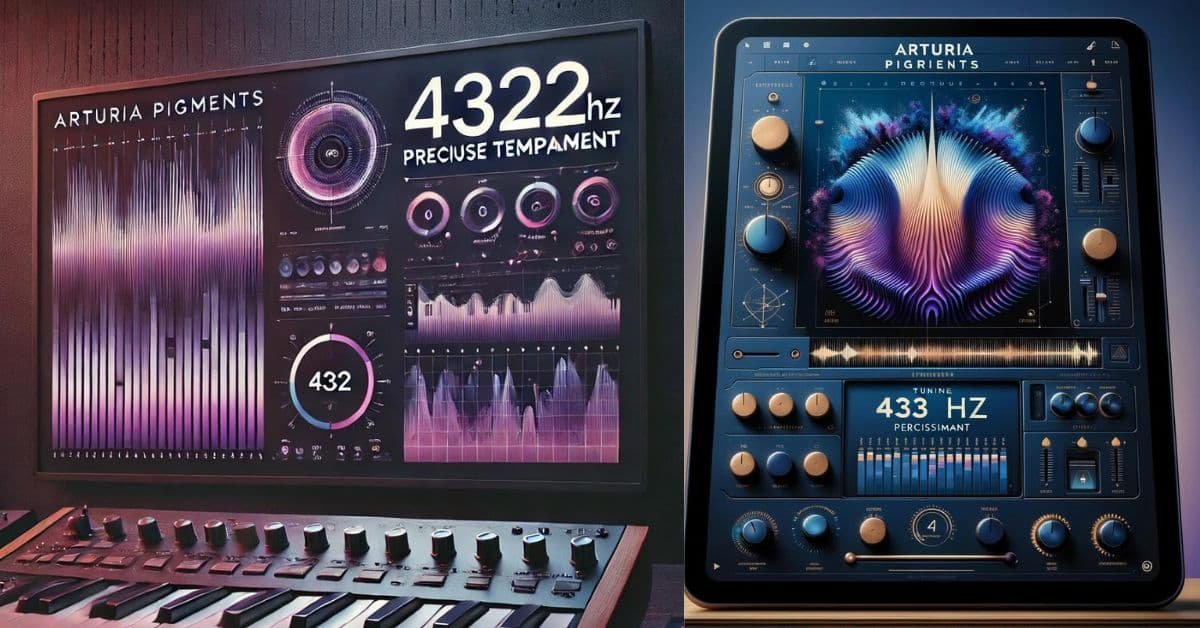Introduction to arturia pigments 432hz precise temprament
Arturia Pigments, a robust virtual synthesizer, has become a staple in modern music production, offering vast sound design possibilities. A unique approach to sound can be found in the 432Hz tuning, a temperament many believe resonates more naturally with the human ear. This article delves into the precise use of 432Hz tuning in Arturia Pigments, exploring how it can enhance your musical creativity.
Understanding Arturia Pigments
Arturia Pigments is renowned for its versatile and intuitive interface, combining wavetable and virtual analog synthesis with granular synthesis and sampling capabilities. Whether you’re a seasoned sound designer or a beginner, Pigments provides a palette of tools to craft unique sounds, making it an ideal platform for experimenting with different temperaments, including 432Hz.
Features and Capabilities
Pigments offer various features that cater to both traditional and experimental sound design. Its dual synthesis engines, extensive modulation options, and real-time visual feedback enable users to sculpt sounds precisely. Additionally, integrating various effects, sequencers, and arpeggiators makes it a comprehensive tool for creating complex compositions.
Benefits of Using Arturia Pigments
The primary advantage of using Arturia Pigments lies in its flexibility. The software’s ability to layer different synthesis methods allows for an unparalleled depth of sound design. Furthermore, the user-friendly interface makes it accessible to musicians of all skill levels. The ability to fine-tune parameters, including temperament, provides a unique edge for producers exploring non-standard tunings like 432Hz.
What is 432Hz Temperament?
The 432Hz tuning is often called “Verdi’s A” or “the natural tuning.” Historically, it is said to align more closely with the universe’s natural frequency, and some believe it creates a more harmonious and soothing listening experience. Although the standard concert pitch is A=440Hz, the 432Hz tuning has gained popularity among specific musicians and sound healing practitioners.
Historical Background
The idea that 432Hz is more natural can be traced back to ancient music theory and the works of renowned composers like Giuseppe Verdi, who advocated for this tuning. However, only in the 20th century that A=440Hz became the standard, primarily due to its adoption by the music industry and regulatory bodies.
Modern Relevance in Music
Today, 432Hz tuning is experiencing a resurgence, particularly in genres such as ambient, meditation, and new-age music. Its proponents argue that it promotes relaxation, reduces stress, and aligns with the body’s natural rhythms, making it a preferred choice for creating calming and meditative soundscapes.
How to Set Precise Temperament in Arturia Pigments
Setting up 432Hz temperament in Arturia Pigments is a straightforward process that requires attention to detail to ensure accuracy. Here’s a step-by-step guide to help you get started:
Step-by-Step Guide
- Open Arturia Pigments: Launch the software and select the initial preset or create a new one from scratch.
- Access the Tuning Section: Navigate to the tuning section, typically found in the global settings or under the master section of the synth.
- Adjust the A4 Frequency: Change the reference frequency from 440Hz to 432Hz by typing in the new value or using the fine-tune controls.
- Fine-Tune Oscillators: If your sound relies on multiple oscillators, ensure each is tuned accurately to maintain the integrity of the 432Hz temperament.
- Save Your Preset: Once satisfied with the tuning, save your preset for future use.
Importance of Precision
Precise tuning is crucial when working with non-standard temperaments like 432Hz. Even slight deviations can affect the overall sound and the intended psychological impact. Using tools like fine-tuning and visual feedback in Pigments helps maintain this precision, ensuring your compositions resonate as intended.
Benefits of Using 432Hz Temperament
The 432Hz tuning is lauded for its aesthetic appeal and its perceived benefits on the listener’s mind and body. While scientific evidence is limited, anecdotal experiences and some studies suggest that this tuning can positively affect both the creator and the audience.
Psychological and Emotional Benefits
Listeners often report a sense of calmness and mental clarity when exposed to music tuned to 432Hz. This frequency resonates more naturally with the human body, reducing stress and heightened emotional responses. This makes 432Hz a popular choice for music therapy and sound healing practices.
Artistic Expression
For musicians, 432Hz offers a unique canvas for expression. The slightly lower pitch compared to 440Hz gives the music a warmer, more organic feel, which can be particularly effective in genres that emphasize atmosphere and emotion. Experimenting with this tuning can open new creative avenues, allowing artists to explore different moods and textures.
Integrating 432Hz Temperament in Your Workflow
Integrating 432Hz into your regular production workflow can be seamless with the right approach. Here are some practical tips to help you incorporate this tuning into your projects:
Practical Tips
- Start with Presets: Use or create presets already tuned to 432Hz, so you don’t have to adjust each time.
- Consistency Across Instruments: If using multiple instruments, ensure all are tuned to 432Hz to maintain harmony.
- Experiment with Genres: Try incorporating 432Hz into different genres to see how it influences the overall sound and feel.
- Use Visual Tools: Utilize spectrum analyzers and tuners to confirm that your instruments are accurately tuned visually.
Examples from Professionals
Many artists specializing in ambient, meditation, and healing music have adopted 432Hz as their go-to tuning. These professionals often cite the frequency’s ability to create a deeper connection with their audience and enhance the immersive quality of their music. Learning from their techniques can inspire your experiments with 432Hz.
Comparing 432Hz to 440Hz
The debate between 432Hz and 440Hz is among the most talked-about topics in the music community. While 440Hz is the industry standard, 432Hz has unique charm and followers.
Differences in Sound
At first listen, the difference between 432Hz and 440Hz may seem subtle, but it’s noticeable over time. Music tuned to 432Hz is often described as softer, warmer, and more pleasant, whereas 440Hz can be perceived as slightly sharper and more intense.
Impact on Listener’s Perception
The impact of 432Hz on listeners can vary. Some feel more relaxed and emotionally engaged when listening to music in this tuning, while others may not notice a significant difference. The perception of sound is subjective, and the choice between 432Hz and 440Hz ultimately depends on the intended emotional impact of the music.
The Science Behind 432Hz
The 432Hz frequency is surrounded by various theories and claims regarding its scientific basis. While some of these claims are rooted in pseudoscience, a few scientific studies support the idea of tuning to natural frequencies.
Frequency and Vibration Theory
Proponents of 432Hz argue that this frequency aligns more closely with natural frequencies, such as the Schumann Resonance (the Earth’s natural vibration). This theory suggests that music tuned to 432Hz is more harmonious with the natural world and the human body.
Studies Supporting 432Hz
Some studies have explored the effects of different frequencies on human physiology, with 432Hz being linked to more relaxed brainwave activity and reduced stress levels. However, more rigorous scientific research is needed to validate these claims fully.
Customizing Arturia Pigments for 432Hz
Arturia Pigments offers extensive customization options that allow you to fully embrace the 432Hz tuning in your sound design process.
Advanced Settings
In addition to basic tuning, you can delve into more advanced settings to optimize your sounds for 432Hz. This includes adjusting modulation sources, applying micro-tuning, and exploring non-standard scales complementing the 432Hz temperament.
Creative Use of Modulation and Effects
Pigments’ powerful modulation matrix and effects section can be used creatively to enhance the unique characteristics of 432Hz tuning. Experimenting with filter modulation, reverb, and delay at 432Hz can lead to new sonic textures and atmospheres.
Real-World Applications
The 432Hz tuning is not just a theoretical concept but has practical applications across various genres and music production environments.
Case Studies
Numerous artists have successfully integrated 432Hz into their music, producing works that resonate deeply with their audiences. From ambient music creators to classical musicians, the use 432Hz is diverse and impactful.
Genre-Specific Uses
While 432Hz is commonly associated with ambient and meditative music, it can also be used in other genres, such as classical, jazz, and electronic dance. The key is experimenting and finding the right balance that suits the genre and your artistic vision.
Exploring Presets and Sound Design in Arturia Pigments
One of Arturia Pigments’ strengths is its vast library of presets, which can be a great starting point for creating 432Hz-tuned music.
Creating Unique Sounds
By starting with a preset and adjusting the tuning to 432Hz, you can quickly create a wide range of sounds, from ethereal pads to dynamic leads. The ability to layer different synthesis engines allows for building complex and evolving textures.
Utilizing Built-In Presets
Arturia Pigments has various built-in presets that can be easily modified to fit the 432Hz tuning. This is particularly useful for producers who want to quickly integrate this temperament into their music without starting from scratch.
Troubleshooting and Optimization
Like any advanced software, working with Arturia Pigments at 432Hz can come with challenges. Here are some tips to help you troubleshoot common issues and optimize your setup.
Common Issues and Solutions
- Tuning Drift: Ensure all oscillators and instruments are correctly tuned to prevent any drift from 432Hz.
- CPU Performance: Pigments can be resource-intensive; consider freezing tracks or using lower-quality render settings during the creative process to avoid CPU overload.
- Compatibility: Check that your DAW and other plugins are compatible with 432Hz tuning to prevent conflicts.
Optimizing Performance
Optimizing your system for 432Hz music production involves managing CPU load, ensuring consistent tuning across all elements, and regularly updating your software to take advantage of the latest improvements and fixes.
Community Insights and Tips
The music production community is a valuable resource for learning and sharing experiences related to 432Hz tuning and Arturia Pigments.
Forums and User Experiences
Online forums and user groups dedicated to Arturia Pigments and 432Hz music provide a wealth of knowledge. Engaging with these communities can help you discover new techniques, troubleshoot issues, and get feedback on your projects.
Expert Opinions
Some of the most innovative uses of 432Hz tuning come from seasoned producers and sound designers. Their insights can provide inspiration and guidance as you explore the possibilities of this unique temperament.
Future of 432Hz in Digital Music
As digital music production continues to evolve, so does the interest in alternative tunings like 432Hz. Here’s what the future might hold.
Emerging Trends
With the increasing interest in wellness and holistic practices, 432Hz will likely gain further popularity in the music industry. This trend is particularly evident in the rise of apps and platforms that promote relaxation and mindfulness through music.
Innovations in Sound Design
New technologies and updates to software like Arturia Pigments will likely introduce even more sophisticated tools for working with 432Hz and other alternative tunings. As sound design’s boundaries expand, so will the creative possibilities.
Conclusion
The art of precise temperament with Arturia Pigments at 432Hz opens up a new dimension in music production, offering unique emotional and psychological benefits. By understanding the science, history, and practical applications of this tuning, you can enhance your music with a sound that resonates deeply with listeners. Whether you’re an experienced producer or a newcomer to 432Hz, Arturia Pigments provides the tools and flexibility to explore this fascinating aspect of sound design.
FAQs
What is 432Hz temperament, and how does it differ from 440Hz?
432Hz is a tuning system that is slightly lower than the standard 440Hz. It is believed to create a more harmonious and calming sound.
Is 432Hz scientifically proven to be better?
While anecdotal evidence and some studies suggest benefits, more scientific research is needed to prove its superiority over 440Hz.
How can I tune other instruments to 432Hz?
Many digital instruments and tuners allow you to adjust the reference pitch to 432Hz. However, for acoustic instruments, you may need to tune each string or note manually.
Can I use 432Hz tuning in other software besides Arturia Pigments?
Yes, most digital audio workstations (DAWs) and virtual instruments allow you to set the tuning to 432Hz.
What are the best genres to experiment with 432Hz?
432Hz is particularly popular in genres like ambient, meditation, and new-age music, but it can be used in any genre to create a unique sound.
Are there any downsides to using 432Hz tuning?
The primary downside is that it deviates from the standard 440Hz tuning, which might cause compatibility issues in collaborative projects or other instruments.





